2015 V Strom 1000 Abs Adventure
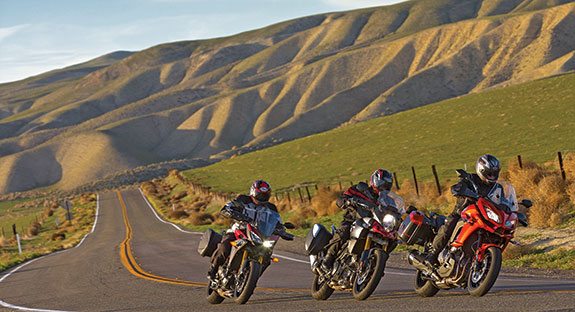
Adventure-styled motorcycles have proliferated in recent years, with many new or extensively updated models introduced by European and Japanese manufacturers. Some are true all-terrain machines, with 19- or 21-inch front wheels to roll over obstacles, sturdy guards and bash plates to protect vital components, and dual-sport tires that cling to virtually any surface.
Others embrace the popular look and creature comforts of adventure bikes but are more style than substance when it comes to off-road prowess. For the vast majority of adventure bike buyers, that's just fine because they have little to no interest in exploring unpaved roads.
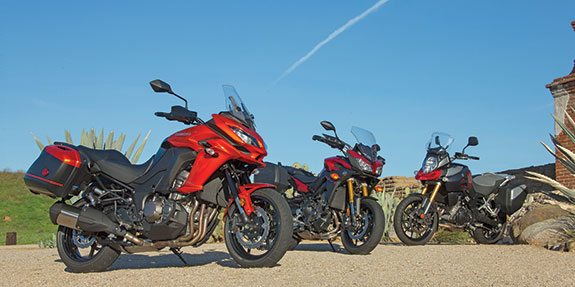
There's a hybrid category that blends design elements of adventure bikes, such as tall, wide handlebars, upright seating positions and long-travel suspension, with those of sport tourers, like high-performance engines and chassis, good wind protection and weatherproof, lockable saddlebags. What to call these genre-straddling motorcycles is debatable—we refer to them as "street adventure" bikes or "crossovers"—but what isn't in doubt is their versatility. Crossovers handle commuting, canyon carving, highway cruising and light touring with equal aplomb.
Advertisement
For this comparison test, we brought together two all-new models—the 2015 Kawasaki Versys 1000 LT and 2015 Yamaha FJ-09 —and one recently updated model—the 2014 Suzuki V-Strom 1000 ABS, which is unchanged for 2015 except for color. Engine configurations differ—the Kawasaki has an in-line four, the Yamaha has an in-line triple and the Suzuki has a 90-degree V-twin—and displacements range from 847cc on the Yamaha to 1,043cc on the Kawasaki, but performance figures are comparable, especially when you take curb weight into account. Since the Versys 1000 LT is the only one with standard saddlebags, we fitted factory accessory saddlebags to the FJ-09 and V-Strom 1000, and as-tested prices are $11,748 for the Yamaha, $12,799 for the Kawasaki and $13,929 for the Suzuki.
Three of us, ranging in age from early 40s to early 60s, all heavier than the "average" 165-pound rider and mature enough to appreciate straight-back riding positions and cushy seats, took this crossover trio on the road for a couple of days. We flogged them on some of our favorite test roads and, if squeezed by Wonder Woman's Lasso of Truth, we'd confess to being enthusiastic with their throttles, and our fuel economy figures reflect such exuberance. We're not front-wheel-up, knee-down kinds of guys, but we gnaw chicken strips down to the gristle. Read on to see how the bikes stack up against one another; refer to the sidebars and spec charts for details on each model.
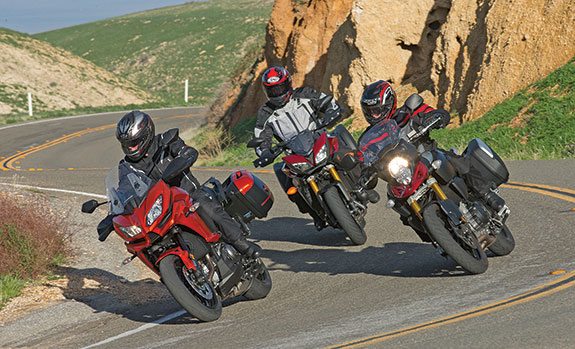
We love potent engines, but we also want them to have exciting character without excessive vibration or noise, and we like power delivered in a smooth, consistent manner. All of these bikes have sportbike-derived engines (see sidebars: Kawasaki, Suzuki, Yamaha), and as the dyno charts below show, they dole out power in a linear fashion and their torque curves are remarkably flat. The Kawasaki's 1,043cc in-line four makes the most peak horsepower (110.2) and torque (69.3 lb-ft), but the Suzuki's 1,037cc V-twin meets or beats it below 7,000 rpm despite peaking at just 93.8 horsepower. The Suzuki makes maximum torque (68.6 lb-ft) at just 4,000 rpm, exactly where you'll be when exiting a tight corner or cruising in top gear and need to make a quick pass, whereas the Kawasaki and Yamaha make maximum torque at 7,200 and 8,400 rpm, respectively. Below 8,000 rpm, the Yamaha's 847cc in-line triple lags behind the others, but its light weight—493 pounds wet vs. 522 pounds for the Suzuki and 564 pounds for the Kawasaki—narrows the disadvantage.
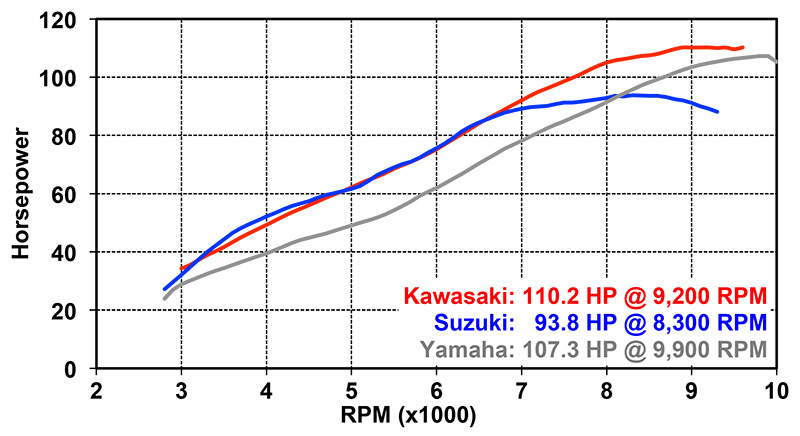
The Versys' in-line four stands out for being silky smooth, with crisp throttle response and rheostat-like power delivery. Although eerily quiet at cruising speeds, it wails like a banshee when given the whip, taking off like a rocket above 7,000 rpm and sending high-frequency vibration through the seat and pegs. The Versys also feels buzzy at the grips on the highway, and it's the only bike where engine heat can be an issue. The V-Strom's loping V-twin sounds and feels great, and it pulls strongly at any rpm but lacks the high-rpm hit of the others. Always relaxed and at-the-ready, neither vibration nor heat bothered us on the Suzuki. The FJ-09's triple has a Jekyll and Hyde quality. On the one hand, it's the most exciting engine of the bunch, with loads of intoxicating, hooligan-esque character. On the other hand, it feels coarse and buzzy on the highway, and, in its full-power A and STD throttle-by-wire engine modes, throttle response is too abrupt (B mode is more user-friendly, but at the cost of reducing output to 96.7 horsepower). The Kawasaki and Suzuki use traditional mechanical throttles, but the Kawasaki can be toggled between two different fuel-injection maps to provide Full and Low power "modes."
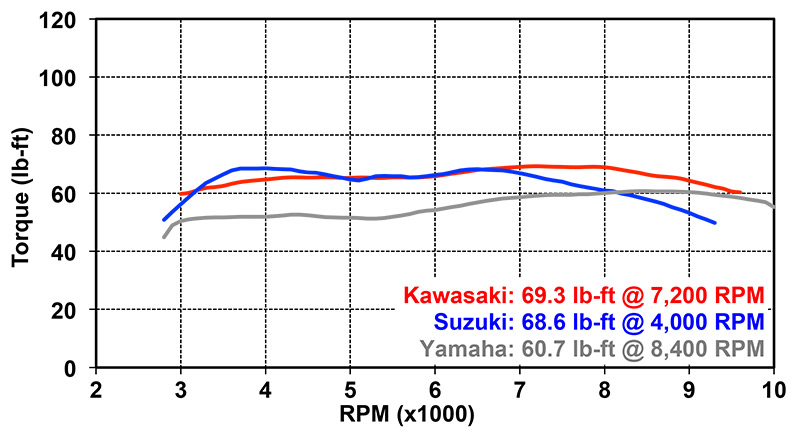
Our test route included a grab bag of curves, everything from perfectly paved, constant-radius sweepers to tight, dirty, decreasing-radius blind corners. All three crossovers can be hustled along at a rapid clip, but they require different levels of effort. With the lightest weight, shortest wheelbase and sportiest steering geometry, the Yamaha is the most nimble, but its touchy throttle, soft suspension, comparatively lackluster brakes and hard tires sapped our confidence. Outweighing the Suzuki and Yamaha by 42 and 71 pounds, respectively, the Kawasaki feels top-heavy and, despite having the widest handlebar, tends to understeer. It may require more effort, but the Kawasaki instilled us with trust that it will go where we point it and not do anything unexpected at an inopportune moment, in part because of its excellent Bridgestone Battlax T30 tires. The Suzuki, which has the longest wheelbase and narrowest handlebar but also the narrowest tires, strikes a balance between the other two in terms of agility and steering behavior. It feels the most natural and neutral.

A major factor in how bikes handle is their suspension and brakes. All have adjustable front and rear suspension, triple-disc brakes and standard ABS. With the lowest base price, it's no surprise that the Yamaha has the worst suspension and weakest brakes. Although a huge improvement over the FZ-09 it's based on, the FJ-09's suspension is too soft and underdamped compared to the others (especially at speed on rough roads), and it lacks the convenience of a remote rear preload adjuster. The Yamaha's brakes are strong, but they require a firm pull at the lever and don't offer much feedback. With the most suspension travel (6.3 inches front/rear), the Suzuki is the only bike designed for light off-road use. Compliance is very good, especially over rough pavement, but overall damping is firm. The Kawasaki won us over with its supple yet responsive suspension, while we were equally impressed with the Kawasaki's and Suzuki's strong, easy-to-modulate brakes.
Because these bikes have adventure in their DNA, they have tall seats, with fixed heights on the Kawasaki (33.1 inches) and Suzuki (33.5 inches) and dual heights on the Yamaha (33.3/33.9 inches). There were few complaints about seat comfort, though the Kawasaki certainly has the broadest and most plush seat with ample room for a passenger. The Suzuki is a close second, whereas the Yamaha's seat is more firm and gives the sensation of sitting up high rather than down in the saddle. Legroom is generous across the board and the wide, upright handlebars allow for neutral, low-stress riding positions. All three have manually adjustable windscreens that do a good job of keeping wind off the rider's torso. With the widest upper fairing and standard hand guards, the Kawasaki has the best overall wind protection. The Yamaha also has hand guards but the Suzuki does not.
When it comes to touring, the higher as-tested load capacities of the Kawasaki (470 pounds) and Suzuki (443 pounds) more easily accommodate a passenger and gear than the Yamaha (367 pounds). Both of the Kawasaki's Givi-made, 28-liter saddlebags will hold a full-face helmet, but neither of the Suzuki's 26-/29-liter saddlebags nor the Yamaha's 22-liter saddlebags will do so, and the Kawasaki's luggage is much easier to open, close and remove.
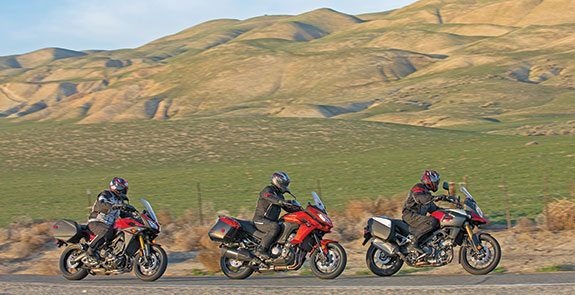
Other touring essentials are hit or miss. The Kawasaki and Yamaha have centerstands—which greatly simplify chain maintenance—but the Suzuki does not. Luggage racks come standard on the Kawasaki and Suzuki, but not on the Yamaha. And the Suzuki and Yamaha have gear position indicators and 12V outlets, but they're absent on the Kawasaki. None come with heated grips. If we added the accessories necessary for all to have these features, as-tested prices would be $11,919 for the Yamaha, $13,381 for the Kawasaki and $14,609 for the Suzuki.
There is a lot to like about each of these crossovers. The Yamaha FJ-09 has the most exciting engine and it is the lightest and least-expensive bike here. But it's biased toward solo riding, it has fueling issues and its suspension and brakes fall well short of the others. With great low-end torque and neutral handling, the Suzuki V-Strom 1000 ABS is also the most versatile by virtue of its 19-inch front wheel, dual-sport tires and rugged build. It has the highest as-tested price, yet lacks basic items like hand guards and a centerstand. For street-biased adventure touring, especially with a passenger and gear, the Kawasaki Versys 1000 LT is our top choice. It's fast, smooth and comfortable, it has the best wind protection and saddlebags, it has the most compliant suspension and it offers good value.
2015 Kawasaki Versys 1000 LT

2015 Kawasaki Versys 1000 LT Specs (READ SIDEBAR & SEE MORE PHOTOS)
Base Price: $12,799
Warranty: 2 yrs., unltd. miles
Website: kawasaki.com
Engine
Type: Liquid-cooled, transverse in-line four
Displacement: 1,043cc
Bore x Stroke: 77.0 x 56.0mm
Compression Ratio: 10.3:1
Valve Train: DOHC, 4 valves per cyl.
Valve Insp. Interval: 15,200 miles
Fuel Delivery: EFI w/ 38mm Keihin throttle bodies x 4
Lubrication System: Wet sump, 4.2-qt. cap.
Transmission: 6-speed, cable-actuated wet slipper clutch
Final Drive: O-ring chain
Electrical
Ignition: TCBI w/ digital advance
Charging Output: 413 watts max.
Battery: 12V 8AH
Chassis
Frame: Twin-spar aluminum w/ tubular-steel subframe & cast aluminum swingarm
Wheelbase: 59.8 in.
Rake/Trail: 27 degrees/4.0 in.
Seat Height: 33.1 in.
Suspension, Front: 43mm USD fork, adj. for spring preload & rebound damping w/ 5.9-in. travel
Rear: Horizontal back-link shock, adj. for spring preload (remote) & rebound damping w/ 5.9-in. travel
Brakes, Front: Dual 310mm petal discs w/ opposed 4-piston calipers & ABS
Rear: Single 250mm petal disc w/ 1-piston pin-slide caliper & ABS
Wheels, Front: Cast, 3.5 x 17 in.
Rear: Cast, 5.5 x 17 in.
Tires, Front: 120/70-ZR17
Rear: 180/55-ZR17
Wet Weight: 564 lbs.
Load Capacity: 470 lbs.
GVWR: 1,034 lbs.
Performance
Fuel Capacity: 5.5 gals., last 1.0 gal. warning light on
MPG: 91 PON min. (low/avg/high) 35.9/38.4/40.0
Estimated Range: 211 miles
Indicated RPM at 60 MPH: 3,600
2014 Suzuki V-Strom 1000 ABS
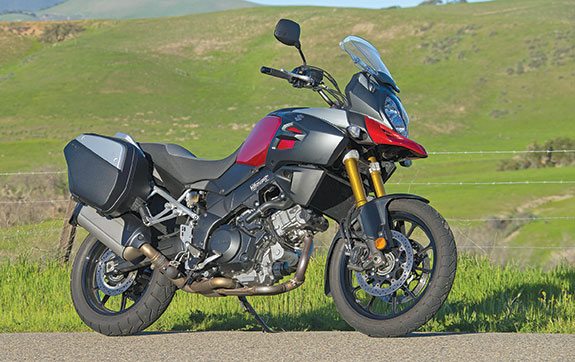
2014 Suzuki V-Strom 1000 ABS Specs (READ SIDEBAR & SEE MORE PHOTOS)
Base Price: $12,699 (same for 2015)
Price as Tested: $13,929 (saddlebags)
Warranty: 1 yr., unltd. miles
Website: suzukicycles.com
Engine
Type: Liquid-cooled, transverse 90-degree V-twin
Displacement: 1,037cc
Bore x Stroke: 100.0 x 66.0mm
Compression Ratio: 11.3:1
Valve Train: DOHC, 4 valves per cyl.
Valve Insp. Interval: 14,500 miles
Fuel Delivery: EFI w/ 45mm throttle bodies x 2
Lubrication System: Wet sump, 3.3-qt. cap.
Transmission: 6-speed, hydraulically actuated wet slipper clutch
Final Drive: O-ring chain
Electrical
Ignition: Electronic transistorized
Charging Output: 490 watts max.
Battery: 12V 12AH
Chassis
Frame: Twin-spar aluminum w/ tubular-steel subframe & cast aluminum swingarm
Wheelbase: 61.2 in.
Rake/Trail: 25 degrees/4.3 in.
Seat Height: 33.5 in.
Suspension, Front: 43mm USD fork, fully adj. w/ 6.3-in. travel
Rear: Linked shock, adj. for spring preload (remote) & rebound damping w/ 6.3-in. travel
Brakes, Front: Dual 310mm discs w/ opposed 4-piston radial calipers & ABS
Rear: Single 260mm disc w/ 1-piston pin-slide caliper & ABS
Wheels, Front: Cast, 2.5 x 19 in.
Rear: Cast, 4.0 x 17 in.
Tires, Front: 110/80-R19
Rear: 150/70-R17
Wet Weight: 522 lbs. (as tested)
Load Capacity: 443 lbs. (as tested)
GVWR: 965 lbs.
Performance
Fuel Capacity: 5.3 gals., last 1.2 gals. warning light on
MPG: 91 PON min. (low/avg/high) 36.3/38.8/41.6
Estimated Range: 213 miles
Indicated RPM at 60 MPH: 3,500
2015 Yamaha FJ-09
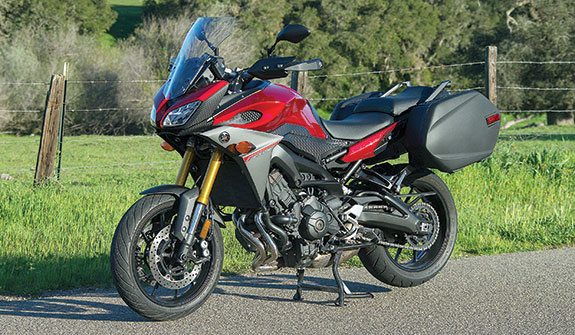
2015 Yamaha FJ-09 Specs (READ SIDEBAR & SEE MORE PHOTOS)
Base Price: $10,490
Price as Tested: $11,748 (saddlebags w/ mounts & lockset, heated grips)
Warranty: 1 yr., unltd. miles
Website: yamahamotorsports.com
Engine
Type: Liquid-cooled, transverse in-line triple
Displacement: 847cc
Bore x Stroke: 78.0 x 59.1mm
Compression Ratio: 11.5:1
Valve Train: DOHC, 4 valves per cyl.
Valve Insp. Interval: 26,600 miles
Fuel Delivery: EFI w/ YCC-T & 41mm throttle bodies x 3
Lubrication System: Wet sump, 2.85-qt. cap.
Transmission: 6-speed, cable-actuated wet clutch
Final Drive: O-ring chain
Electrical
Ignition: TCI/32-bit ECU
Charging Output: 415 watts max.
Battery: 12V 8.6AH
Chassis
Frame: Aluminum controlled-fill die-cast perimeter w/ tubular-steel subframe & cast aluminum swingarm
Wheelbase: 56.7 in.
Rake/Trail: 24 degrees/3.9 in.
Seat Height: 33.3/33.9 in.
Suspension, Front: 41mm USD fork, adj. for spring preload & rebound damping w/ 5.4-in. travel
Rear: Linked shock, adj. for spring preload & rebound damping w/ 5.1-in. travel
Brakes, Front: Dual 298mm discs w/ opposed 4-piston radial calipers & ABS
Rear: Single 245mm disc w/ 1-piston pin-slide caliper & ABS
Wheels, Front: Cast, 3.5 x 17 in.
Rear: Cast, 5.5 x 17 in.
Tires, Front: 120/70-ZR17
Rear: 180/55-ZR17
Wet Weight: 493 lbs. (as tested)
Load Capacity: 367 lbs. (as tested)
GVWR: 860 lbs.
Performance
Fuel Capacity: 4.8 gals., last 0.7 gal. warning light on
MPG: 91 PON min. (low/avg/high) 36.7/40.3/46.1
Estimated Range: 222 miles
Indicated RPM at 60 MPH: 4,000
Advertisement
You can read sidebars about each bike and see more photos by clicking on the links below:
2015 Kawasaki Versys 1000 LT
2014 Suzuki V-Strom 1000 ABS
2015 Yamaha FJ-09
2015 V Strom 1000 Abs Adventure
Source: https://ridermagazine.com/2015/05/08/comparison-2015-kawasaki-versys-1000-lt-2014-suzuki-v-strom-1000-abs-2015-yamaha-fj-09/

Komentar :
Posting Komentar